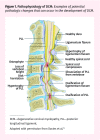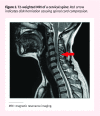Degenerative cervical myelopathy: Diagnosis and management in primary care
- PMID: 31515310
- PMCID: PMC6741789
Degenerative cervical myelopathy: Diagnosis and management in primary care
Abstract
Objective: To raise awareness about degenerative cervical myelopathy (DCM) and to help family physicians identify, diagnose, and manage DCM more effectively.
Sources of information: A PubMed search was conducted for articles published between 1970 and October 2017, using the terms cervical myelopathy and degenerative spinal cord injury with family medicine or primary care.
Main message: Owing to limited knowledge of DCM in primary care, along with the large variability of the disease, the diagnosis of DCM is often missed or delayed. The natural course of DCM presents as a stepwise decline, with symptoms ranging from muscle weakness to complete paralysis. All individuals with signs and symptoms should be referred to a spine surgeon for consideration of surgery; those with mild DCM might be offered conservative treatment but should receive a surgical evaluation and opinion nonetheless. Asymptomatic patients with evidence of cord compression on magnetic resonance imaging might need to be referred for assessment; however, surgery is not advised. It is critical to closely monitor asymptomatic individuals or those with mild DCM for neurologic deterioration.
Conclusion: Degenerative cervical myelopathy is the most common cause of spinal cord dysfunction in adults. This review helps streamline its diagnosis in primary care, allowing for improved chances of early diagnosis and prevention of further neurologic decline among patients.
Copyright© the College of Family Physicians of Canada.
Figures



References
-
- Johnson RL, Gerhart KA, McCray J, Menconi JC, Whiteneck GG. Secondary conditions following spinal cord injury in a population-based sample. Spinal Cord. 1998;36(1):45–50. - PubMed
-
- Anson CA, Stanwyck DJ, Krause JS. Social support and health status in spinal cord injury. Paraplegia. 1993;31(10):632–8. - PubMed
-
- National Spinal Cord Injury Statistical Center. Spinal cord injury. Facts and figures at a glance. Birmingham, AL: University of Alabama at Birmingham; 2017. Available from: www.nscisc.uab.edu/Public/Facts%20and%20Figures%20-%202017.pdf. Accessed 2019 Jul 19.
-
- Kalsi-Ryan S, Karadimas SK, Fehlings MG. Cervical spondylotic myelopathy: the clinical phenomenon and the current pathobiology of an increasingly prevalent and devastating disorder. Neuroscientist. 2013;19(4):409–21. Epub 2012 Nov 30. - PubMed
Publication types
MeSH terms
LinkOut - more resources
Full Text Sources
Medical
Research Materials
